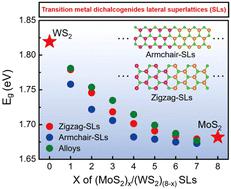Our official English website, www.x-mol.net, welcomes your
feedback! (Note: you will need to create a separate account there.)
Electronic property modulation in two-dimensional lateral superlattices of monolayer transition metal dichalcogenides
Nanoscale ( IF 5.8 ) Pub Date : 2022-06-23 , DOI: 10.1039/d2nr02189g Hongshuai Zou 1 , Xinjiang Wang 2 , Kun Zhou 1 , Yawen Li 1 , Yuhao Fu 2 , Lijun Zhang 1
Nanoscale ( IF 5.8 ) Pub Date : 2022-06-23 , DOI: 10.1039/d2nr02189g Hongshuai Zou 1 , Xinjiang Wang 2 , Kun Zhou 1 , Yawen Li 1 , Yuhao Fu 2 , Lijun Zhang 1
Affiliation

|
Fabricating lateral heterostructures (HSs) and superlattices (SLs) provides a unique degree of freedom for modulating the physical properties of two-dimensional (2D) materials by varying the chemical component, geometric size and interface structure in the ultra-thin atomic thickness limit. While a variety of 2D lateral HSs/SLs have been synthesized, especially for transition metal dichalcogenides (TMDs), how such structures affect quantitatively the physical properties of 2D materials has not yet been established. We herein explore electronic property modulation in 2D lateral SLs of monolayer TMDs through first-principles high-throughput calculations. The dependence of the electronic structure, bandgap, carrier effective masses, charge density overlap on chemical components, interface type, and sub-lattice size of lateral TMD-SLs are investigated. We find that by comparison with their random alloy counterparts, the lateral TMD-SLs exhibit generally type-II band alignment, a wider range of bandgap tunability, larger carrier effective masses, and stronger electron–hole charge separation tendency. The bandgap variation with a sub-lattice size shows larger bowing parameters for the SLs with heterogeneous anions, by comparison with the homogeneous anion cases. A similar behavior is observed for the SLs with an armchair-type interface, by comparison with the zigzag-type interface cases. Further analyses reveal that the underlying physical mechanism can be attributed to the synergistic interplay among the band offset of sub-lattices, quantum confinement effect, and existing internal strain.
中文翻译:

单层过渡金属二硫化物二维横向超晶格中的电子特性调制
制造横向异质结构 (HSs) 和超晶格 (SLs) 通过在超薄原子厚度极限内改变化学成分、几何尺寸和界面结构,为调制二维 (2D) 材料的物理性质提供了独特的自由度。虽然已经合成了各种二维横向 HSs/SL,尤其是过渡金属二硫属化物 (TMD),但这些结构如何定量地影响二维材料的物理性质尚未确定。我们在此通过第一性原理高通量计算探索单层 TMD 的二维横向 SL 中的电子特性调制。研究了横向 TMD-SL 的电子结构、带隙、载流子有效质量、电荷密度重叠对化学成分、界面类型和亚晶格尺寸的依赖性。我们发现,与它们的随机合金对应物相比,横向 TMD-SL 通常表现出 II 型能带排列、更广泛的带隙可调性、更大的载流子有效质量和更强的电子-空穴电荷分离趋势。与均质阴离子情况相比,具有亚晶格尺寸的带隙变化显示出具有异质阴离子的 SL 更大的弯曲参数。与锯齿型接口案例相比,具有扶手椅型接口的 SL 观察到类似的行为。进一步的分析表明,潜在的物理机制可归因于子晶格的能带偏移、量子限制效应和现有内部应变之间的协同相互作用。横向 TMD-SL 通常表现出 II 型能带排列、更宽的带隙可调范围、更大的载流子有效质量和更强的电子-空穴电荷分离趋势。与均质阴离子情况相比,具有亚晶格尺寸的带隙变化显示出具有异质阴离子的 SL 更大的弯曲参数。与锯齿型接口案例相比,具有扶手椅型接口的 SL 观察到类似的行为。进一步的分析表明,潜在的物理机制可归因于子晶格的能带偏移、量子限制效应和现有内部应变之间的协同相互作用。横向 TMD-SL 通常表现出 II 型能带排列、更宽的带隙可调范围、更大的载流子有效质量和更强的电子-空穴电荷分离趋势。与均质阴离子情况相比,具有亚晶格尺寸的带隙变化显示出具有异质阴离子的 SL 更大的弯曲参数。与锯齿型接口案例相比,具有扶手椅型接口的 SL 观察到类似的行为。进一步的分析表明,潜在的物理机制可归因于子晶格的能带偏移、量子限制效应和现有内部应变之间的协同相互作用。与均质阴离子情况相比,具有亚晶格尺寸的带隙变化显示出具有异质阴离子的 SL 更大的弯曲参数。与锯齿型接口案例相比,具有扶手椅型接口的 SL 观察到类似的行为。进一步的分析表明,潜在的物理机制可归因于子晶格的能带偏移、量子限制效应和现有内部应变之间的协同相互作用。与均质阴离子情况相比,具有亚晶格尺寸的带隙变化显示出具有异质阴离子的 SL 更大的弯曲参数。与锯齿型接口案例相比,具有扶手椅型接口的 SL 观察到类似的行为。进一步的分析表明,潜在的物理机制可归因于子晶格的能带偏移、量子限制效应和现有内部应变之间的协同相互作用。
更新日期:2022-06-23
中文翻译:

单层过渡金属二硫化物二维横向超晶格中的电子特性调制
制造横向异质结构 (HSs) 和超晶格 (SLs) 通过在超薄原子厚度极限内改变化学成分、几何尺寸和界面结构,为调制二维 (2D) 材料的物理性质提供了独特的自由度。虽然已经合成了各种二维横向 HSs/SL,尤其是过渡金属二硫属化物 (TMD),但这些结构如何定量地影响二维材料的物理性质尚未确定。我们在此通过第一性原理高通量计算探索单层 TMD 的二维横向 SL 中的电子特性调制。研究了横向 TMD-SL 的电子结构、带隙、载流子有效质量、电荷密度重叠对化学成分、界面类型和亚晶格尺寸的依赖性。我们发现,与它们的随机合金对应物相比,横向 TMD-SL 通常表现出 II 型能带排列、更广泛的带隙可调性、更大的载流子有效质量和更强的电子-空穴电荷分离趋势。与均质阴离子情况相比,具有亚晶格尺寸的带隙变化显示出具有异质阴离子的 SL 更大的弯曲参数。与锯齿型接口案例相比,具有扶手椅型接口的 SL 观察到类似的行为。进一步的分析表明,潜在的物理机制可归因于子晶格的能带偏移、量子限制效应和现有内部应变之间的协同相互作用。横向 TMD-SL 通常表现出 II 型能带排列、更宽的带隙可调范围、更大的载流子有效质量和更强的电子-空穴电荷分离趋势。与均质阴离子情况相比,具有亚晶格尺寸的带隙变化显示出具有异质阴离子的 SL 更大的弯曲参数。与锯齿型接口案例相比,具有扶手椅型接口的 SL 观察到类似的行为。进一步的分析表明,潜在的物理机制可归因于子晶格的能带偏移、量子限制效应和现有内部应变之间的协同相互作用。横向 TMD-SL 通常表现出 II 型能带排列、更宽的带隙可调范围、更大的载流子有效质量和更强的电子-空穴电荷分离趋势。与均质阴离子情况相比,具有亚晶格尺寸的带隙变化显示出具有异质阴离子的 SL 更大的弯曲参数。与锯齿型接口案例相比,具有扶手椅型接口的 SL 观察到类似的行为。进一步的分析表明,潜在的物理机制可归因于子晶格的能带偏移、量子限制效应和现有内部应变之间的协同相互作用。与均质阴离子情况相比,具有亚晶格尺寸的带隙变化显示出具有异质阴离子的 SL 更大的弯曲参数。与锯齿型接口案例相比,具有扶手椅型接口的 SL 观察到类似的行为。进一步的分析表明,潜在的物理机制可归因于子晶格的能带偏移、量子限制效应和现有内部应变之间的协同相互作用。与均质阴离子情况相比,具有亚晶格尺寸的带隙变化显示出具有异质阴离子的 SL 更大的弯曲参数。与锯齿型接口案例相比,具有扶手椅型接口的 SL 观察到类似的行为。进一步的分析表明,潜在的物理机制可归因于子晶格的能带偏移、量子限制效应和现有内部应变之间的协同相互作用。











































 京公网安备 11010802027423号
京公网安备 11010802027423号